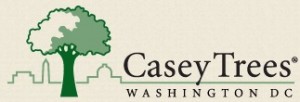A typical picture of a forest is one full of lush, green landscapes, never ending rows of trees, and wildlife only found in wooded areas. Well, the forest I am working in this summer is full of people, buildings, and roadways. Trees have existed in cities for centuries, and it has been a source of pride in many places. Washington, D.C. is one example of a city that understands the importance of providing ample trees and overall green space for its residents. My passion for trees has brought me to Casey Trees, an urban forestry non-profit in the nation’s capital. My internship is in the Technical Services and Research (TS&R) department, headed by Dr. Jessica Sanders. I was brought on to conduct field research along with three other students.

Casey Trees strives to protect and enhance Washington, D.C.’s tree canopy through education, advocacy, and research. There are volunteer activities, tree-planting events, children’s day-camps, and an active citizen forestry community. Casey Trees is comprised of several different departments, such as communication and development, planning and design, and education. TS&R is the department that I am a part of, and I am assessing trees and gathering data. A major project in this department is the Tree Report Card, which is a unique annual assessment of the city’s tree canopy. My colleagues and I have been collecting tree data for a survival study in order to help comprise the “tree health” portion of the report. The data collected will also help to inform other urban forestry organizations and advocates of current practices and operations. Using an ArcGIS application, we travel by bicycle in teams of two to different areas of the city every day.
There are several components of this internship that I was initially intrigued by, with the cycling portion being one of them. Who wouldn’t want to have one of their job requirements be to own a bike? Having never lived in a bike-friendly area, I was excited to get to leave the car behind, lower my carbon footprint, and get in some exercise after an exceptionally long New York winter. It has been great doing just that, although I did hit a few road bumps (pun very much intended). It was just a friendly little reminder that everyone should look out for cars and other unexpected obstacles. In addition to that, the scientific aspect of the internship was a significant point of interest. Bard Center for Environmental Policy (CEP) is meant to prepare me to enter a science and research based job, and I was ready to put that to the test.
The Study
Tree survival data is essential in understanding what happens to the thousands of trees that are planted in various locations, such as private yards, schools, streets, and parks. In order to quantify the growth in canopy coverage or addition of tree benefits, we must first know how many of the trees planted are surviving. Casey Trees has different programs to get trees in the ground, one of which is a Tree Rebate program. A homeowner can send in a receipt for a tree they purchased to receive a rebate. This means that we do not actually see the tree go in the ground, so follow-up work is that much more important to understand how the tree is doing.
The survival study that I am a part of this summer analyzes a 51% sample of all Casey Trees trees that were planted between 2003 and 2011, which is approximately 4,600 trees. We are analyzing several different factors, all of which encompass health, growth, and planting site. Selecting one data point on the ArcGIS Collector application brings up one specific tree along with its particular tree number. The species type is listed, which helped us identify a tree if it were in a large plot with several others of different species around it.

The aspects that we analyze and edit are:
- Diameter breast height (DBH) (in)
- Tree height (ft)
- Crown width, north-south and east-west (in)
- Tree structure (ranked lowest to highest 1-5)
- Root flare zone (ranked 1-5)
- Crown condition (ranked 1-5)
- Space type (front yard, back yard, side yard, planting strip, tree box, road median, maintained land, natural area)
- Missing (%)
- Impervious area (%)
- Overall health (good, poor, dead, missing)
DBH, height, and crown width help us determine growth rate, while structure, foot flare, and crown condition help us determine the overall health. We also keep track of “missing” trees, which include trees that are either removed due to construction or development, or trees that were removed by homeowners.
Moving forward from the field

Over the course of the first month of the field study, my team and I gathered valuable knowledge about species identification, tree disease, optimal habitats, and how to stay cool in the sweltering D.C. heat. Coming here from such an academically challenging first year at Bard CEP has certainly been a change of pace, but the learning process has not halted at all. It has been invaluable to be a part of the environmental non-profit field. Once the field study concludes, I will be staying on with Casey Trees to analyze the data gathered and work alongside the Technical Services & Research department to assist them further. Every year we can come to a better understanding of how the work Casey Trees is doing affects the tree canopy of Washington, D.C.
